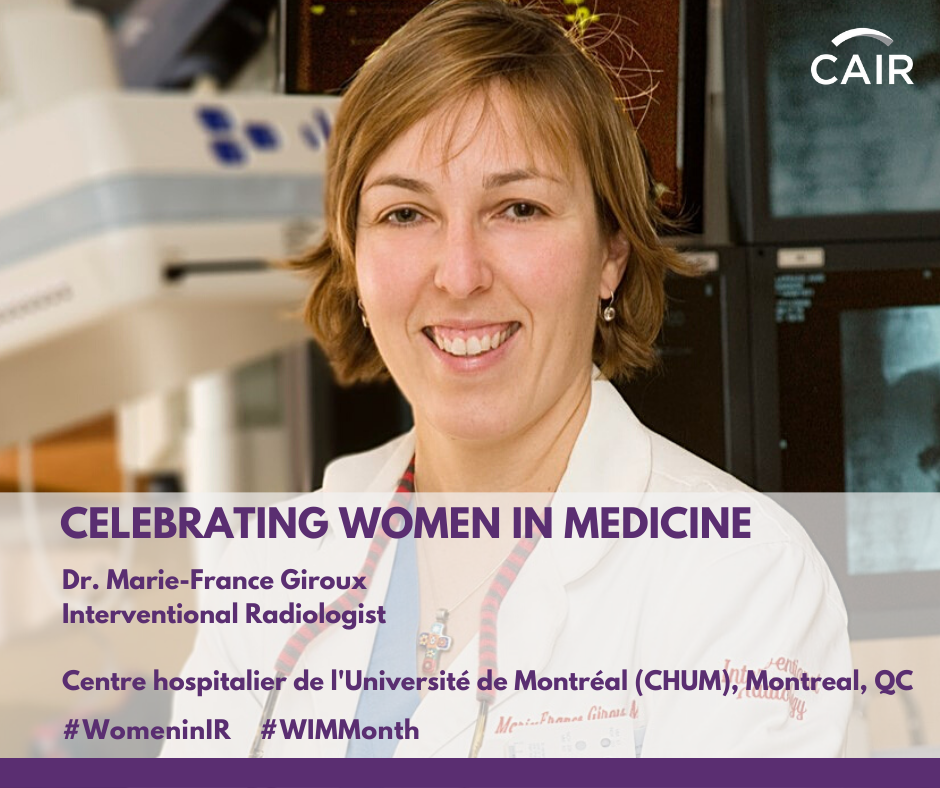There’s a story behind every woman working in IR. This September, as part of the Women in Medicine month, we are happy to offer you an insight into their inspiring journeys – if you’d like to participate in an Women in IR interview or you’d like to recommend someone to be interviewed, please contact us for more information.
 Dr. Marie-France Giroux studied medicine at the Université de Sherbrooke from 1991 to 1995. She then undertook her residency in diagnostic radiology at the Université de Montréal in 1995 and finished in 2000, followed by a fellowship in interventional and vascular radiology in 2001 at the Hospital of the University of Pennsylvania in Philadelphia. She completed her medical training in Bordeaux, France, where she underwent a specialized Doppler training program in 2001.
Dr. Marie-France Giroux studied medicine at the Université de Sherbrooke from 1991 to 1995. She then undertook her residency in diagnostic radiology at the Université de Montréal in 1995 and finished in 2000, followed by a fellowship in interventional and vascular radiology in 2001 at the Hospital of the University of Pennsylvania in Philadelphia. She completed her medical training in Bordeaux, France, where she underwent a specialized Doppler training program in 2001.
Dr. Giroux has been practising since 2001 at the Centre hospitalier universitaire de Montréal (CHUM), and was appointed associate professor in 2011. She developed a clinical mentoring program (fellowship) in interventional radiology at the CHUM.
From 2003 to 2013, Dr. Giroux was an active member of the Canadian Association for Interventional Radiology (CAIR) Board of Directors. Moreover, from 2007 to 2009, she was CAIR’s first woman president of the board. Through her efforts and those of her fellow directors, interventional radiology was recognized as a subspeciality in Canada in 2015.
What brought you to interventional radiology?
It is funny how people end up where they are; when I entered medical school, I wanted to become an orthopedic surgeon or a neurosurgeon. When I was in medical school, I met an orthopedic surgeon who hated his job and told me never to do orthopedic surgery, and I did not like the outcomes of neurosurgery patients. I stumbled upon a radiologist and he was so passionate about his work that I decided it was what I wanted to do. Then, when I was an R2, interventional radiologists did all the drainages and biopsies. One day, when Dr. Oliva was on service, he walked me through a liver biopsy and I instantly fell in love with the field. I loved the brain part and technical parts of IR.
What is one thing that is exciting about the future of IR?
The field of Interventional Radiology is an ever-expanding field, we are constantly discovering new ways to solve problems. Oncology for example was a restricted field in IR that only blossomed and made a staggering progress in the past15 years.
What are some of the challenges women working in IR are facing?
The most challenging part of being a woman pursuing a career in IR is lack of time. There is a certain difficulty in balancing personal life with career. This is why it is so important to have role models that can be looked up to and get inspired by.
When I was a fellow, I was doing a procedure with an attending who was male. We suddenly heard the woman breathe heavily, the attendings immediately thought about allergic reaction and asked the technologist to five the patient a dose of Benadryl. I decided to go and see the patient beforehand, and she told me she was very anxious. After talking to her and comforting her, she calmed down, and of course, did not need the Benadryl. My attendings later told me: “We really need a woman in our team! Having a different perspective is sure to improve the service we give to our patients.”
Any hobbies, what do enjoy doing outside of work?
We are a family of downhill skiers, and we will go almost every week-end during the cold season. We also enjoy wind surfing and mountain biking. It is always great to spend energy outside of work and spend time with family. I also enjoy playing the piano.